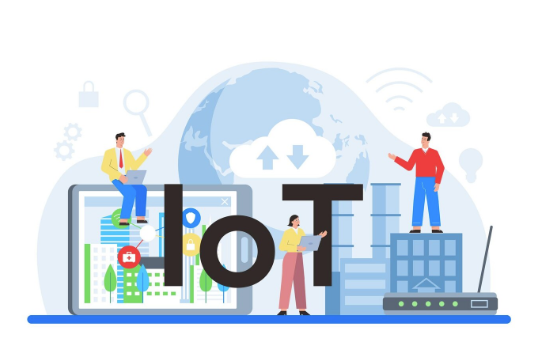In the last few years, the availability of affordable computers, sensors, and fine connectivity has been a major driver in the commercial viability of the Internet of Things (IoT). With IoT, it is possible to link sensor objects to the Internet, share information, and observe their relations. According to recent surveys, many multinational companies are fast adopting IoT solutions.
However, given the current number of IoT devices and the resultant data, it is possible to send all that data to the cloud. While edge computing has the potential to entail this massive onslaught of data. Edge computing helps data analysis at the source to lighten the load on the data centers while at the same time avoiding excessive latency to ensure that the businesses operate more smoothly.
What is the IoT?
The Internet of Things (IoT) is a connection and networking of objects that fit with electronics, software, sensors, or even RFID and can transfer data and commands. IoT devices include home devices such as smart refrigerators, smart TVs, cooking ranges, and industrial devices such as large manufacturing machines.
IoT is primarily focused on connectivity, as devices are designed to exchange data. IoT devices can be connected through WiFi, cellular, or wired connections. IoT aims to create a networking platform for devices to be connected, gather information, and facilitate automation and decision-making procedures. However, simply participating in the IoT network does not mean being on the “edge.”
Use Cases in the Internet of Things (IoT)
Auto IoT: Automotive IoT uses sensors, gadgets, and internet connections on automobiles to enable predictive maintenance and ensure the safety of the automobiles. With the help of IoT, the owners of connected cars are able to view their car’s state or status and be informed and receive updates on maintenance and other similar matters.
Smart Home System: The smart home is one of the most famous applications of IoT recently. In a smart home, all those items that are used in daily tasks are connected to the smart home system, which then controls and operates the devices you have, no matter where you are.
Smart Cities System: Smart cities require a huge IoT environment empowered with applications and sensors to collect important information. Analyzing this data at the source will enable cities to enhance their service delivery and operate more effectively.
Industrial Sector IoT: It includes all the devices applied within manufacturing industries and other related sectors. These devices are connected to an internal tracking system that controls KPIs and other aspects to keep things running smoothly.
What is Edge Computing?
Edge computing focuses on where data processing and computation. Traditionally, data management involves forwarding the data produced by the devices to data facilities or data clouds. Here comes edge computing that challenges this paradigm by closing the processing power to the data source.
The ‘edge’ is about the computing equipment being located near the device that is producing the data. It is the opposite of cloud computing; edge computing performs computations directly using the device or at the edge server located nearby. It has various benefits, including minimized latency, improved security, and more effective bandwidth usage.
Some of the Use Cases in Edge Computing
Manufacturing Process: Edge computing is used to enable the collection of information on the manufacturing process and decision-making. Manufacturers place sensors along production lines, which gives manufacturers information on the health of the machine and subsequently the existence of production problems before an error happens.
Automobiles: The use of autonomous vehicles is one of the best examples. Vehicle data must be processed, and its analysis should take place when the car is moving; otherwise, the data is not relevant. At the edge devices, the data is analyzed in real-time, and the output immediately helps vehicle navigation.
Healthcare Sector: Edge computing is revolutionizing the healthcare sector, where the processing of data is done in an instant; hospitals can enhance the quality of client services, especially after the clients have left the hospital. Wearable healthcare gadgets are used to monitor chronic patients, and when a risky reading or a patient’s suspicious behavior occurs, caregivers are alerted.
Some of the other uses are training staff by employing augmented reality and virtual reality, remote control of movements of health equipment, and conducting robot-assisted surgery.
Similarities of IoT and Edge Computing
IoT has some similarities to edge computing. Concisely, both technologies capture information within a distributed computing environment. Both technologies:
- Utilize sensors to collect data.
- Give data on a large scale.
- They are both relatively new techniques that are transforming data utilization.
IoT vs Edge Computing: What’s the Best Option?
In conclusion, IoT focuses on device connection and networks. It involves control of available channels, interactions, and traffic of information flows between multiple interconnected devices. On the other hand, the goal of edge computing is based on the location of processing and decision-making, focusing on the decentralization of processing.
Some IoT devices may be part of the edge computing infrastructure; however, not all IoT devices lie at the edge. IoT devices can interface with a cloud or data center, whereas edge devices only do computations locally. The edge helps in quick analysis and decision-making and reduces the dependence on external resources.
That’s why evaluating the difference between Edge and IoT is very important to stay on top of innovations. IoT is the technology and protocols uniting the devices and the Internet, while edge computing means computation proximity to the sources of information.
Through the combination of Edge and IoT, organizations can enhance data processing, as well as achieve shorter response times to unlock new opportunities in different domains, such as smart cities and healthcare and industrial sector automation. The great collaboration between Edge and IoT plays an important role in future technologies of our interconnected world.
